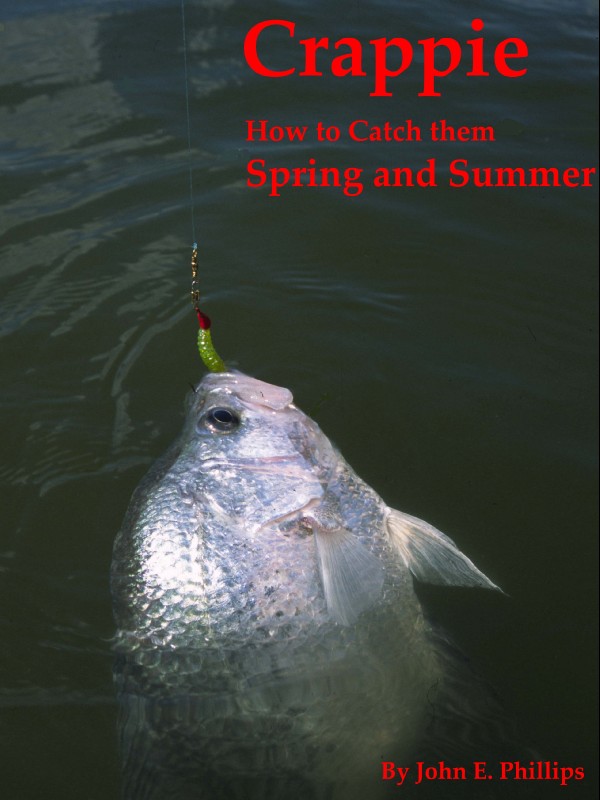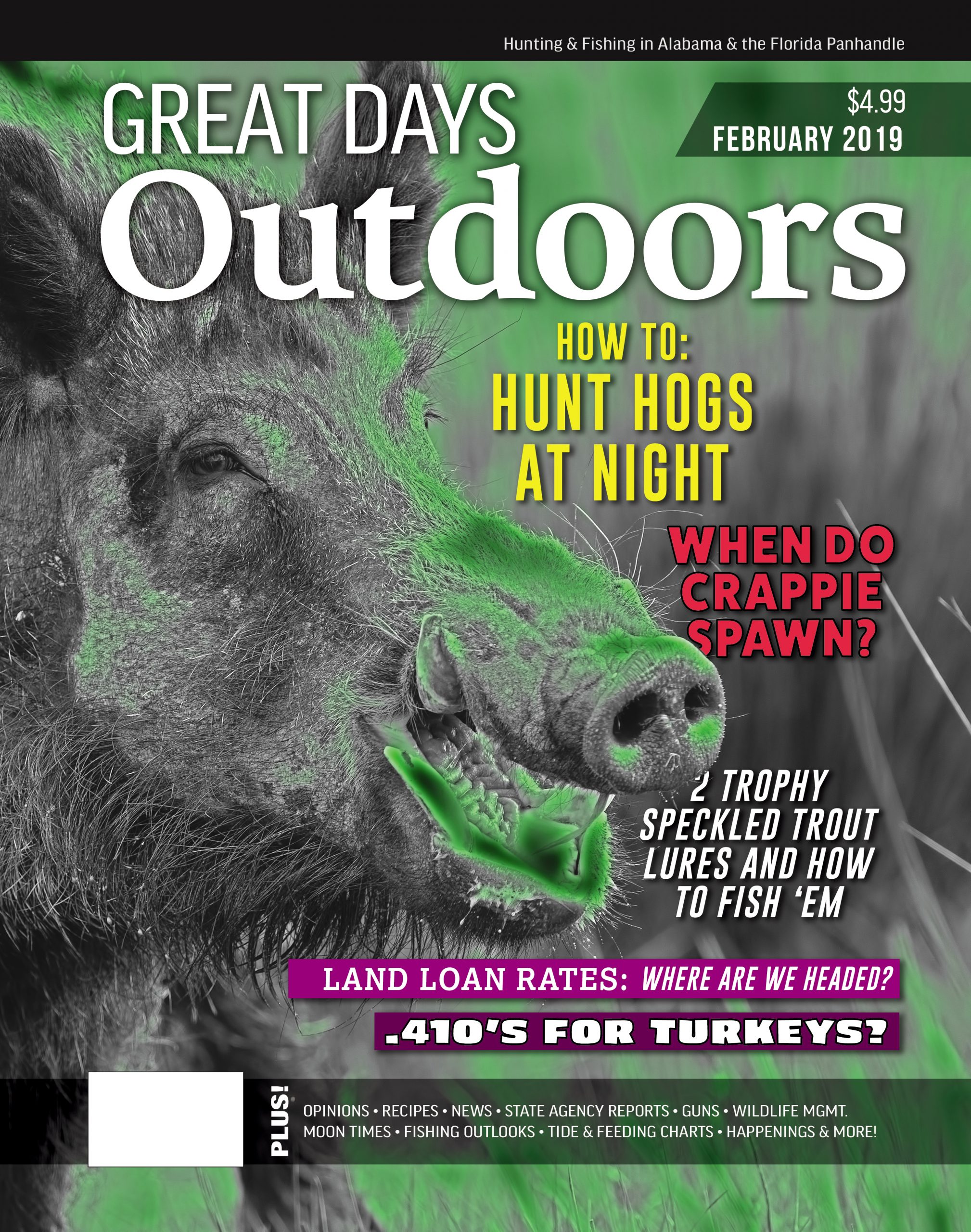As winter begins to fade and water temperatures begin to rise, crappie anglers know that the spawning season is approaching. Knowing when crappie spawn, pre spawn crappie locations, and how to catch them while they are spawning will have you filling your ice chest with slabs in no time.
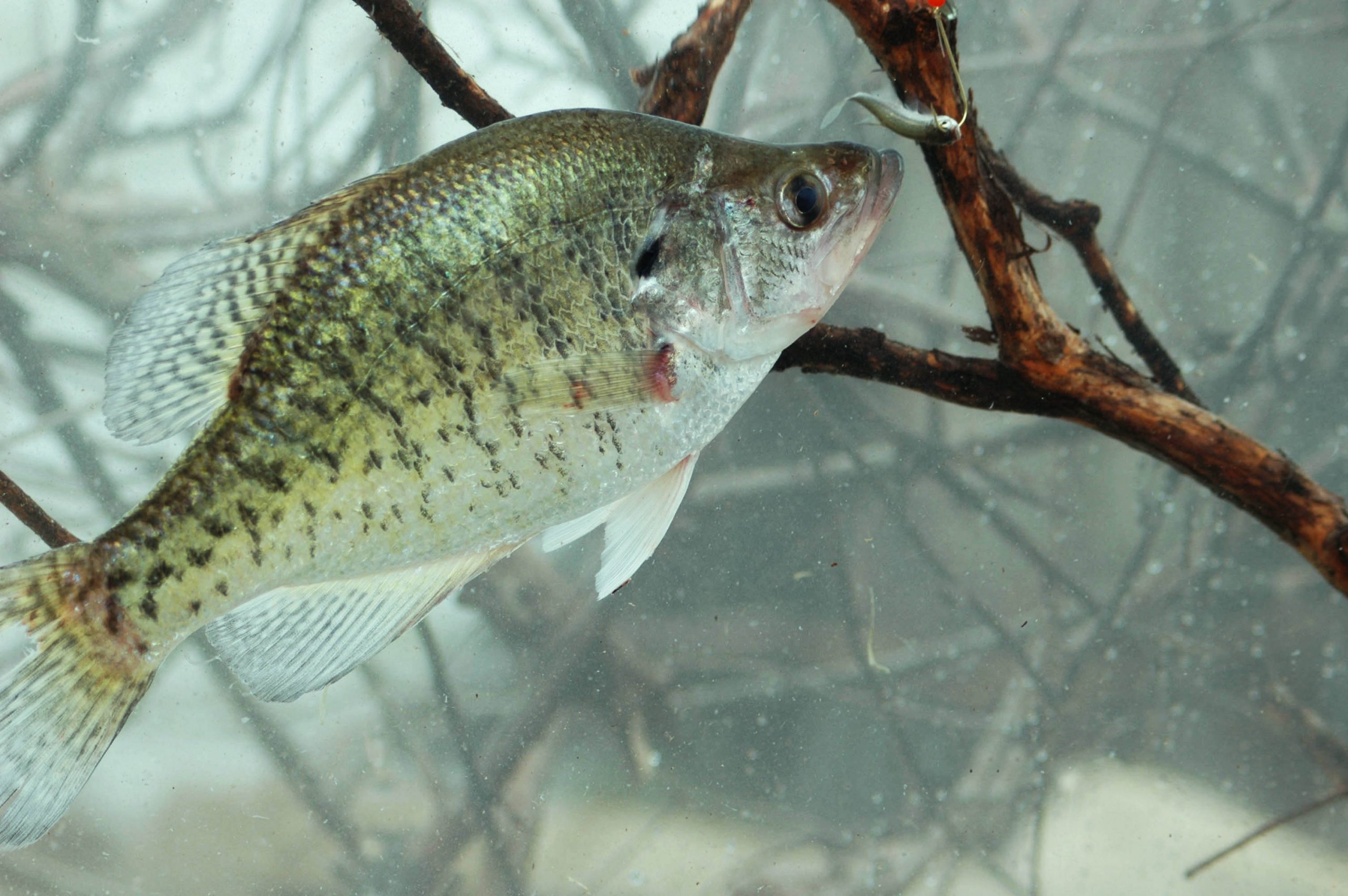
According to Nick Nichols, Alabama’s Chief of Fisheries, “The clarity of the water, the water temperature and the conditions on various types of water all influence when crappie spawn.”
Although several different factors determine when crappie spawn on any body of water, Nick Nichols, Chief of Fisheries for Alabama’s Department of Conservation, says that crappie, both black and white, traditionally spawn when the water temperature is in the high 50s or low 60s.
Nichols explains, “In some areas, the black crappie will spawn a few weeks earlier than the white crappie. Another factor to consider about the crappie spawn is that crappie like to spawn right on the edge of light penetration into the water. For instance, if crappie are spawning in 6 to 8 feet of water in a clear body of water, and a big rain event occurs, crappie may move up and spawn in 2 to 3 feet of water to remain on the edge of the light penetration down into the water. The clarity of the water, the water temperature and the conditions on various types of water all influence when crappie spawn. But the major factors seem to be water temperature and light penetration.”
What National Crappie Fishing Pros Know about the Spawn
Ronnie Capps of Tiptonville, Tennessee, winner of many championship crappie tournaments across the United States, says that, “Generally black crappie spawn first each year in the lakes we fish. But the white crappie always seem to wait for 59 degree water temperature before beginning their spawning. I’ve learned that rising water and that 59 degree water temperature mean that crappie will move into the more shallow water to spawn. On stable lakes, the male crappie will move-up in the water column to find structure where the females can spawn.”
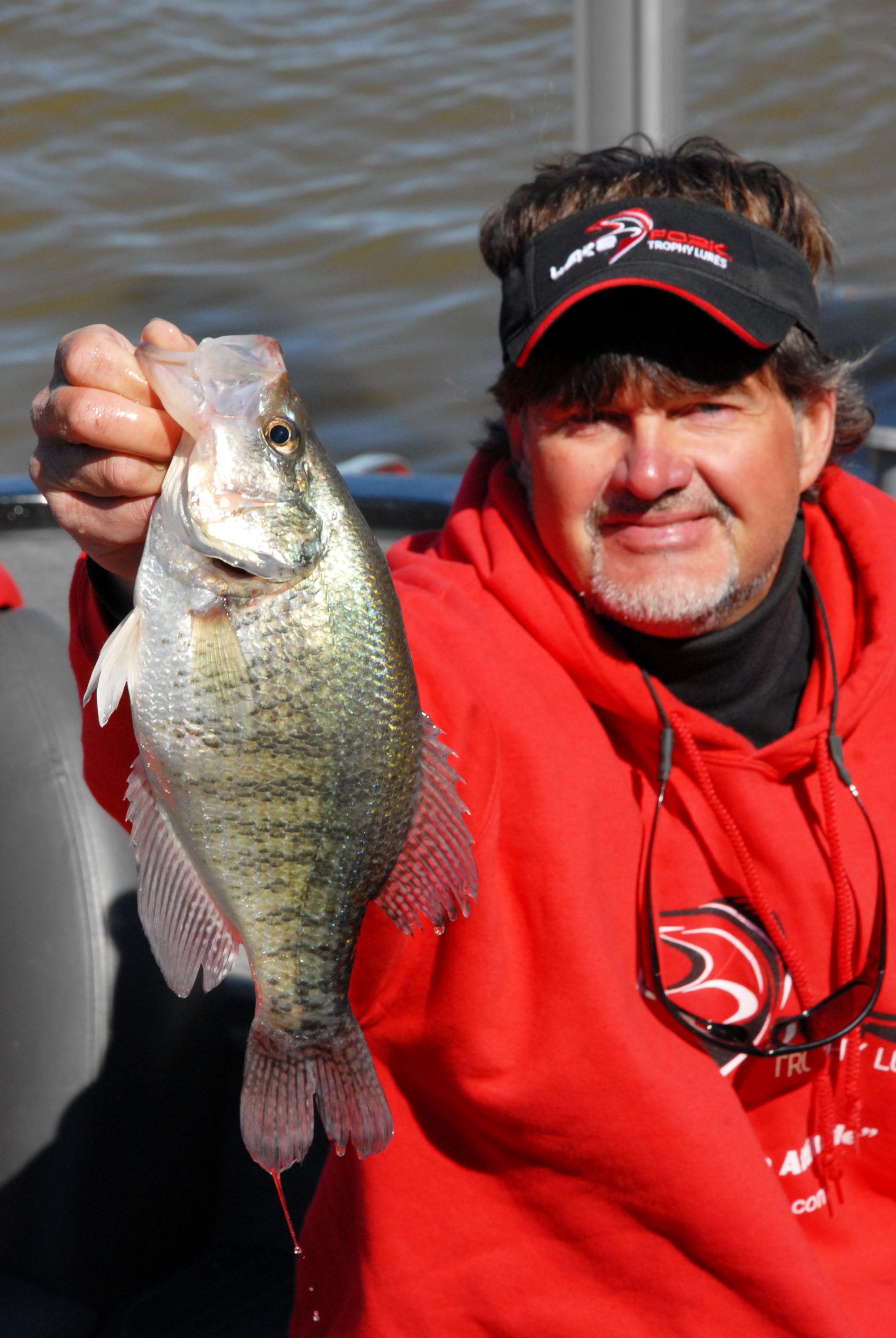
When a cold front hits during the spawn, Ronnie Capps, pictured here, says it brings, wind, rain and wave action, which makes controlling your boat difficult, although you still can catch crappie.
“A cold front that moves in during the spawn brings wind, waves and rain – factors that don’t exist when the weather’s stable. The waves cause baits to jump, which generally may keep crappie in many places from biting. I’m convinced the colder temperatures don’t impact your crappie catching during a cold front as much as the wave action does, since it affects the fisherman’s ability to control the bait.”
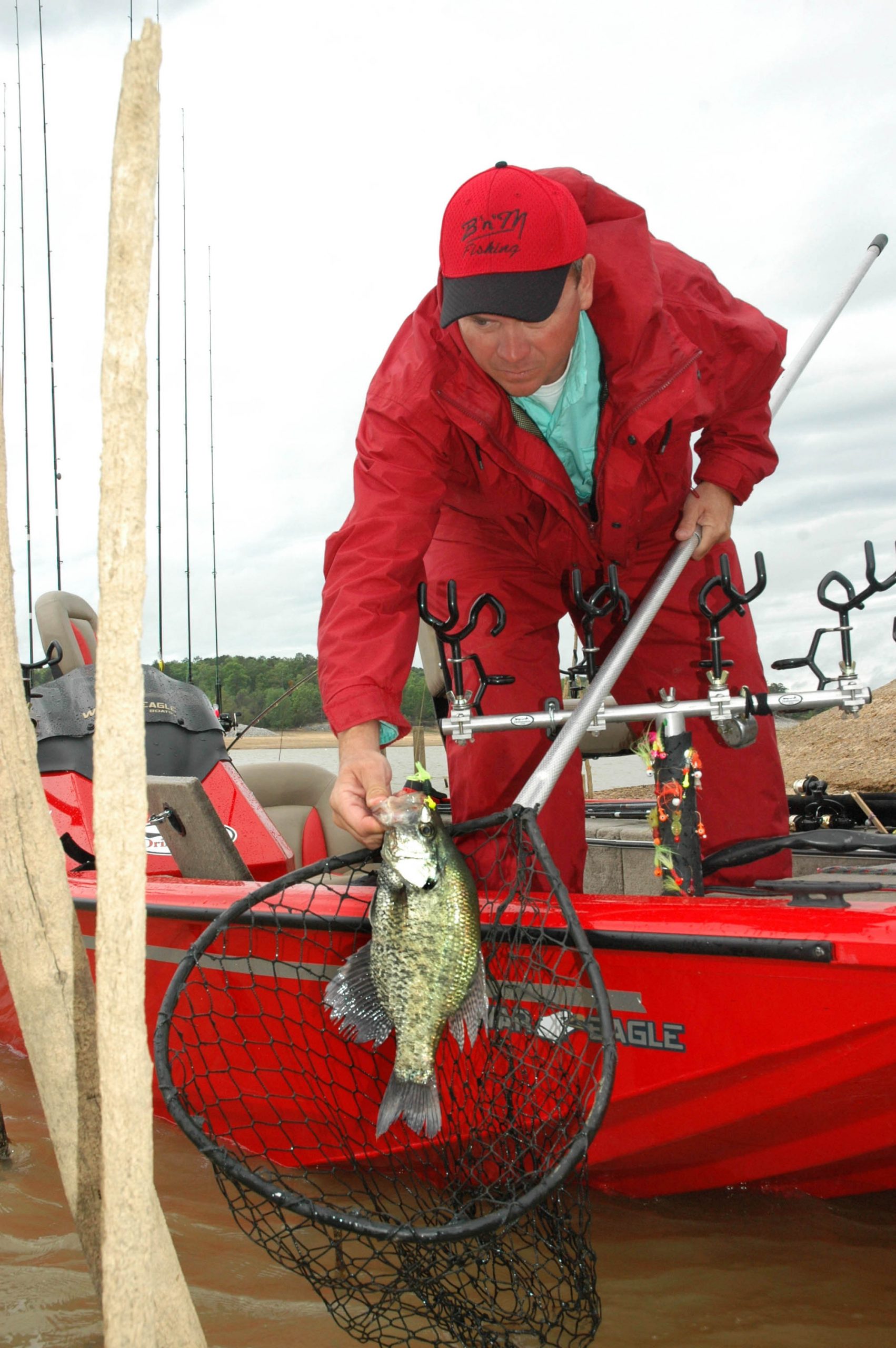
In February, the crappie often start moving to the north ends, most specifically the northwest ends of lakes, before the spawn, according to Kent Driscoll.
Kent Driscoll of Nolensville, Tenn., another national crappie-fishing pro, says in February, “The crappie are starting their spring migration, moving from deep water, up the creeks and near the spawning flats to prepare for the spawn. A large number of crappie will be moving to the north ends, more specifically the northwest ends of most lakes, since these sections of the lakes often heat-up first.”
Pre-Spawn Crappie Locations
You can catch some nice-sized crappie in the pre-spawn, if you know where to look for them. Here are recommendations from tournament fishermen across the nation.
* Identify “Waterfowl De-Watering” Areas. On water systems with de-watering areas for waterfowl, during the prespawn, the water from these duck ponds will drain back into the river or lake. Warmer than the main body of water and often loaded with nutrients that draw baitfish, this water attracts large numbers of fat, prespawn crappie. Fish the areas where this water re-enters the main river or lake. Look for shallow bays, beaver ponds or big shallow sloughs cut off from the main river. During the prespawn, crappie move into these places first searching for the correct water temperature to spawn. You’ll find the most crappie in shallow, warm-water bays just before the spawn.

“During the prespawn and the spawn, crappie will hold at the light penetration depth,” Nick Nichols, Alabama’s Chief of Fisheries, reports.
* Sight-Fish for Prespawn Crappie. Before crappie begin the spawn, you’ll locate them wherever you find large schools of shad. If you live on a lake or a river where you can see seagulls diving on shad, you’ll have pinpointed a productive place to catch prespawn crappie. Crappie below the school will force the shad to the surface where the birds will attack them. Fishing jigs or minnows under diving birds will allow you to locate and catch plenty of crappie. On a warm day, you can spot the schools of shad on the surface, even if you don’t see a bird diving on them. Often, crappie will come from their deep-water haunts to feed on those surface shad.
* Use Bass Fishermen as Birddogs. Sometimes bass fishermen build brush shelters at the mouths of creeks on points. During the prespawn, crappie often will hold on these brush shelters on points that lead into creeks where they’ll spawn. When you hear bass fishermen reporting strikes on points with no success, more than likely they’ve had crappie instead of bass attack there. Brush piles in 10 to 20 feet of water on major points leading into creeks are a great pre spawn crappie location to search.

Catching crappie can be fairly easy, once you find the fish, whether you’re fishing prespawn or during the spawn
* Find Crappie in the Mouths of Creeks. Before crappie move up into the creeks to spawn, they may suspend in large schools in the mouths of creeks and in open water 50 to 200 yards from the mouths of creeks. To catch these crappie, either troll or cast jigs through the schools. Once you start to catch crappie, drop a buoy to pinpoint the school, and cast to it. When the crappie quit biting, use your depth finder to relocate the schools, and change the color of your jig to continue to catch crappie from that same school
.* Troll the Ledges. During the prespawn, crappie frequently hold on underwater creek ledges close to the spawning grounds. By using your trolling motor to move very slowly along the edge of a creek channel, you may catch large numbers of big crappie when you troll jigs.
* Locate Shallow-Ditch Crappie. You’ll also find crappie during the prespawn in little ditches only a foot or two deep coming off creek channels and leading into spawning areas. Crappie will move into these ditches and hold there waiting on the right water temperature to spawn.
* Fish for Dock Crappie. Lake residents may show you where to find productive brush piles that hold crappie in the prespawn. If you notice a dock that either has poles on it or pole holders on the front, there’s a very good chance you’ll find a hot, prespawn crappie spot in front of that dock. Most lakeside residents will build brush shelters about a pole’s length from the ends of their docks in 8 to 15 feet of water. These brush shelters are a pre spawn crappie locations where fish will hold all season long.
* Hunt Cover, Not Crappie. During the prespawn before the crappie move shallow, you’ll catch crappie under stumps, roots and brush that you won’t spot on your depth finder. For this reason, search for cover. Even if you don’t see any crappie, begin to fish through and around the underwater cover. Many times you’ll take a good number of big crappie on spots where you never actually see the fish.
* Catch ‘Em Deep. During the prespawn in deep, clear lakes like Smith Lake in north Alabama, you may find crappie in water 30 to 40 feet deep. These fish often hold on underwater humps or ledges and in large, tight schools. Use your depth finder to locate the schools, and then fish vertically with either minnows or jigs. When the crappie quit biting minnows, switch to jigs for bait, or, change to minnows if you’ve used jigs. If you don’t have minnows, change the color and/or style of jig you’re fishing. Crappie become color-wise relatively quickly. To catch a limit of keepers, you may have to change colors several times to make the fish continue to bite.

Ronnie Capps, pictured here, says, “I’ve caught spawning crappie later and deeper at deep lakes, like Alabama’s Smith Lake, than in lakes where the water rises in the spring.”
Capps explains that, “I have caught spawning crappie later and deeper at Alabama’s Smith Lake than in lakes where the water rises in the spring. I’ve found the type of lake, the depth of the water and the clarity of the water, besides water temperature, all affect when and where the crappie will spawn.” * Troll Minnows Simultaneously at Two Depths Along Creek Channels. Place a 1/4-ounce sinker on the end of your line. Then 18 inches above the sinker, tie a 6 to 8 inch loop in the main line. Put the end of the loop through the eye of the hook and then over the point of the hook. Next, pull the loop back to the eye of the hook. This technique will hold your hook in place and away from the main line. Move 18 inches up from the first loop, and tie a second 6 to 8 inch loop in the line. Attach a hook in the same manner as before. Bait both hooks with minnows, lower the lead down until it touches bottom, reel it up 6 to 12 inches off the bottom, and put one or two rods out using this type of rig on each side of the boat.
Using your trolling motor, slowly move your boat along the breakline of an underwater creek channel. Keep one side of the boat on the deep-water side of the breakline and the other side of the boat on the shallow-water side of the breakline.
* Fish Rough Stuff. To catch prespawn crappie, you’ll often have to fish in some of the thickest cover you can find in deep water. Many crappie fishermen will fish the outside edges of that cover. However, if you want to catch the most and the biggest crappie, fish right through the heart of the thick stuff. As one old timer once told me, “If you’re not breaking off jigs, straightening hooks, busting your line and losing your leads, you’re not fishing a pre-spawn crappie location.”
* Find Underwater Highways and Railroads – Many man-made lake impoundments encompass underwater places where railroads and highways once crossed creeks and rivers. If you locate those old roadbeds, you may discover a great pre spawn crappie location. In addition, underwater bridges, bridge pilings and other vertical structure will provide places for crappie to concentrate near almost any depth of water where they feel comfortable. Remember the drastic water changes usually present on either side of bridge pilings, since engineers often construct pilings on the edges of underwater creek channels.
* Fish Concrete, Prespawn crappie will look for warm water close to deep water. Concrete bridges, locks, dams and piers catch the heat from the sun and transfer that heat into the water. Often you’ll catch crappie where you find concrete. Many anglers have had success taking crappie during the pre-spawn near a concrete loading dock on the edge of a creek channel. If you build a brush shelter next to the concrete, you’ll have one of the most productive spots on the lake or river to catch crappie during the prespawn.
* Catch Discharge Crappie. If you can locate a creek or an area of the lake with a warm-water discharge coming from a factory or a plant, you’ll also find the most prespawn crappie there. The fish will move into these warm-water discharges because that’s where they the feel most comfortable, and where they’ll find the most bait. Look for the crappie to hold in the first or second eddy pool closest to the warm-water discharge yet out of the current. These are great pre-spawn crappie locations.
What Five Secrets Catch Prespawn Crappies
Driscoll gives these secrets to catch more prespawn crappie:
- Fish where the crappie are holding, which requires scouting and looking for fish before you start fishing. I use my depth finder and GPS to locate the crappie.
- Match your equipment to the style and the technique of crappie fishing you plan to fish. For instance, during the prespawn, you know that the crappie have to eat, but they also have to conserve energy. I’ll use lighter weights and longer poles and fish much slowly than at any other times of the year.
- Choose your lakes carefully. During the prespawn, select the lakes near you to fish that have the most crappie in them.
- Downsize your baits, depending on the types of conditions you’re fishing. If a cold front’s coming in, the barometer’s going crazy, the area has a full moon, and the crappie don’t want to bite, you’ll have to entice them to bite. Many times you can do this by downsizing your baits. Although I like to use big baits in the prespawn I may use a jig as small as a 1/48-ounce.
- Use different types of line under various lake conditions in the prespawn. In clear water, you can’t use high-vis blue or green or yellow line. You must fish small, clear line then.

Kent Driscoll explains that during the prespawn, he fishes with lighter weights and longer poles and fishes more slowly than he does the rest of the year.
By knowing when crappie spawn and the places to look for where the crappie are holding during the prespawn, you usually can catch more big crappie then and have less fishing pressure.
Learn More about Crappie
To understand more about crappie, check out John E. Phillips’ books, available in Kindle and some also in print and Audible (http://johninthewild.com/books#crappie). To receive and download for free “The Crappie Catchers’ Cookbook,” by John and Denise Phillips, go to http://johninthewild.com/free-books.
How to Get the Best Information for Lakes to Crappie Fish in the Prespawn
To get the most-accurate and timely information about the lake you fish for spawning crappie, contact your state’s fish and wildlife section to learn the name and phone number of the fisheries biologist on that lake to contact him or her.

The fisheries biologist responsible for the lake or river you will be fishing, is your new best friend, when it comes to info about pre-spawn crappie locations.
How Long Does the Crappie Spawn Last
According to crappie fishing expert Ronnie Capps, “Many anglers believe the crappie spawn only lasts for 2 weeks, but professionals also have learned that crappie may spawn even up into the summer. The crappie spawn doesn’t happen all at once. I’ve seen some male crappie go on a bed in early March and still be on the nest in early June, with females coming and going to the nest.”
This article first appeared in the February 2019 print issue of Great Days Outdoors Magazine. For more great hunting and fishing content for the deep South, subscribe to Great Days Outdoors print and digital editions or click the image to download this issue.

